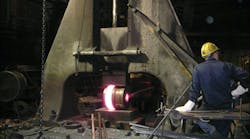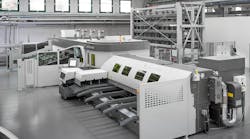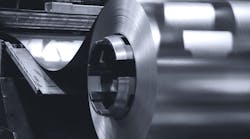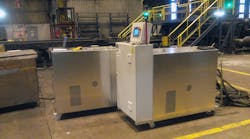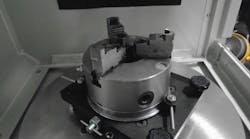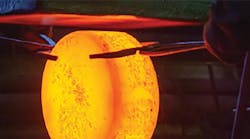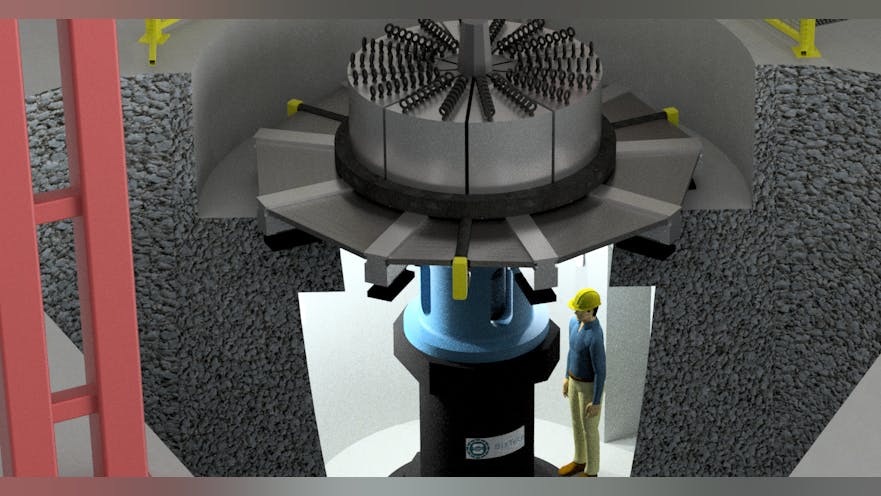Ring rolling is a process in which a heated, toroidal-shaped workpiece is compressed between the rolls of a ring-rolling mill, which increases the part diameter and transforms the cross-section based on the tooling shape. High-capacity ring production equipment is needed to support aircraft, industrial gas turbines, pipe, and pressure vessel manufacturing, which call for strong, solid, symmetrical parts. These industrial applications depend upon forged cylinders for critical components.
Industrial, power and energy, aerospace, and construction markets have maintained steady demand for rolled rings over the past decade, but there is a step in this production process that is somewhat overlooked: ring sizing. Engineers with experience in forging established SizTech LLC in 2019, and offered these insights to the sizing process, which involves specialized machinery for ring expanding and shrinking.
Expansion process and technology — “Sizing” a part before finish machining can result in less material waste. Ring expanders are used to accurately size and improve the roundness of cylindrical parts, and this is accomplished by eliminating machining allowances to compensate for out-of-roundness. Or, using profiled tooling a part can be completely formed on an expander, which can reduce or eliminate the need for finish machining. In either case, machining costs and cycle time are reduced.
Another advantage of the expansion process is improving a workpiece’s material microstructure, among other material properties. For example, cold expansion relieves internal stresses and corrects distortions due to heat treatment, while hot expansion results in elongated grains in the circumferential direction, which improves ductility.
Many forged metals can benefit from the expansion process. Typical materials sized on SizTech expanders include carbon steel, alloy steel, stainless steel, aluminum, and titanium.
Seamless rolled rings — Seamless rolled-ring production typically begins with a cylindrical preform that is near the mass of the desired ring. Allowance for piercing the center of the cylinder is added to the initial mass. The preform is upset and pierced in an open die to form a toroidal shape.
While the temperature of the ring is still above the recrystallization temperature, it is placed on a ring-rolling mill. Ring-rolling mills use roll sets to form the toroidal part into a larger ring by compressing the wall in the radial and/or axial direction.
After a seamless ring is formed on a ring roller it may be heat treated, and then it is typically machined.
The final machined parts are used in a range of applications and industries: Large bearing races for wind turbines, large-diameter pipe flanges, and engine components for aircraft and spacecraft are some of the highly visible examples of parts machined from seamless rings.
SizTech ring expansion — Ring-rolling operations create compressive and tensile stresses on the wall and center of the cross-section, respectively. Ring-rolling mills can accurately size low-alloy steels, carbon steels, and many aluminum alloys. However, harder alloys may develop significant internal shear stresses at the compressive and tensile stress boundaries during ring rolling. This phenomenon occurs mostly during the final planishing phase on the ring roller.
Adding a SizTech expander to the ring production process, results in two key benefits. First, the ring can be rolled slightly undersized with larger reductions, and the final planishing cycle can be decreased. The ring is then sized to the final diameter on the expander. This results in faster ring rolling cycle times. Second, when the ring diameter is increased to the target diameter on a forging expander — it not only improves the inner-diameter accuracy but exposes the entire cross-section to tensile load, relieving the internal shear stresses.
Often, rings are heat treated after rolling. Heat treating also can create internal stresses in the material, which may result in ring distortion. In some cases, the internal stresses may not create distortions until the part is being machined, at which point one stress overtakes the other due to the material removal.
Sizing the ring after heat treatment can correct distortions and improve the structural stability of the part.
Allowance for machining the inner and/or outer diameters of the ring can solve this issue at the cost of the extra material. However, when a rolled ring is sized on a forging expander the inner diameter tolerance will be equal to the outer diameter tolerance of the expander tooling. Machining allowances can be reduced significantly or eliminated entirely when the correct tooling is used.
Tooling also can be stacked to extend significantly the range of diameters that can be sized on a single machine.
SizTech improves upon the advantages of expanders currently in the field. Like many other models, SizTech expanders use automatic ring indexing and helpful control capabilities like process recipe selection/storage. However, the machines’ control systems also monitor the sizing process in real time and can compensate for phenomena like elastic spring-back, which changes along with the material strain.
The capabilities of SizTech control systems also include compensating for thermal expansion (or retraction during cooling) of the hot ring. These tools are essential for optimizing the final diameter of the sized ring, reducing stock material that requires removal, and ultimately reducing material costs. SizTech designs sizing equipment to realize these benefits for rings of any diameter, height, and cross-section.
Supplemental technology considerations — While many applications benefit from forging expanders, some applications would benefit more from a forging shrinker. These are machines that reduce the diameter of a ring by compressing the outer surface. A forging shrinker typically is used when there are tight tolerances on the outer diameter of a ring, as the O.D. tolerance of the shrunk ring will match the tolerance of the shrinker tooling. Like the expanding process, the shrinking process also reduces the internal shear, however the cross-section will experience a compressive load rather than a tensile load.
Expanders and shrinkers offer several important benefits to any seamless-ring producing operation. SizTech expanders and shrinkers can be equipped with tools to improve efficiency and decrease cycle time. Ring indexing is implemented to eliminate the flat surfaces that are created in the gaps of the expanding jaws. SizTech machines typically include index rollers to automate ring indexing.
Shrinkers can be equipped with a lifter in the center of the machine to create a platform for easier insertion and removal by crane or manipulator.
Finally, during periods of high usage, expanders and shrinkers can be exposed to extreme heat. As the machine temperature rises, efficiency may decrease; however, expander and shrinker jaws can be water-cooled to protect the machine. These and other features may be added according to the assessment of individual applications.
Additional applications and services — SizTech provides machines, parts, and services in the U.S. and internationally, and has a global network of customers and vendors. The SizTech team has more than 80 years of metal forming experience, and relationships with companies like Dango & Dienenthal for material handling proficiency and Rexroth for expertise in hydraulic power systems. This allows SizTech to provide customers with quality solutions that can be easily integrated to existing layouts and processes.
Ryan Pinto is a Senior Mechanical Engineer at SizTech LLC. Contact him at [email protected], or learn more at www.siztech.com
